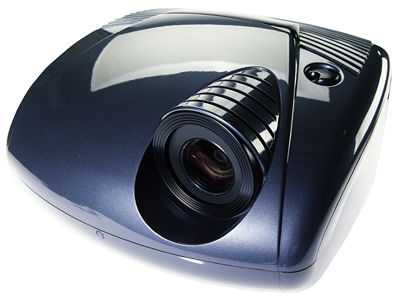SIM2 Grand Cinema HT300 DLP video projector

DLP projectors and CD players have much in common: Each is a digital replacement for an older, more expensive, less convenient analog technology. The CD, however, never fulfilled Sony's promise of "perfect sound forever." Even after almost 20 years of continuous improvement of the technology, a first-rate CD player can still be sonically outperformed by a top-flight analog LP system. Hopefully, DLPs will more quickly achieve their goal, and make it possible for everyone to have unobtrusive, easy-to-install projectors capable of producing a big, beautiful, totally cinematic experience.
White Heat, White Light
To achieve its magic, Texas Instruments' proprietary DLP technology uses a color wheel combined with a chip full of tiny mirrors. SIM2 Multimedia's Grand Cinema HT300 contains the latest generation of TI's DLP chip, the HD1. Its 921,600 mirrors, each representing a single pixel, are configured in a true 16:9 shape, giving it a native resolution of 1280x720. Or, to use a CRT analogy, its native vertical resolution is 720 lines; 720p sources require no scaling whatsoever.
Marantz and Sharp are currently producing HD1-based projectors, and Dwin and Runco (see this month's "First Look") will release models soon. What differentiates these manufacturers' offerings is how they implement TI's chip. Some buy a basic chassis or "engine" and add their own processing boards; others, like Sim2, build their projectors from the ground up, which permits greater optimization. The HT300 sends 480p, 480i, and 1080i signals through its built-in Pixelworks scaler; 480i sources also pass through the unit's internal Faroudja DCDi deinterlacer. The HT300 uses a specially color-corrected, six-segment, 3x (180rps) color wheel to minimize the rainbow effect and to achieve a neutral gray scale.
SIM2 doesn't make their own lenses; Fujinon makes the lens in the HT300, to SIM2's specifications. Not only is this lens a special long-throw zoom so the projector can be placed near the back of a room, well behind the viewers; it also has a very large effective coverage area so that SIM2 could incorporate a vertical physical-shift correction into the design. This is no mere frill, but makes it possible to set up the HT300 with much greater precision. Unlike projectors that rely solely on their electronic shift and keystone features to correct geometric problems resulting from nonstandard installations, the HT300 gives its users a much wider range of placement options. The combination of SIM2's electronic keystone-adjustment ranges of 26° vertical and 20° horizontal, plus 16° of physical vertical shift, means that the HT300 can do everything but the Limbo.
The HT300's sensual curves aren't just for looks—that chassis shape has several functional purposes. The cooling fan's intake and exhaust are on the bottom of the unit, so light leakage is minimal. The power supply is in the back, with cooling vents directly above it—any heat generated there is easily dissipated. A knob for the physical lens shift is on top, near the lens, countersunk into the chassis. All the controls on the remote are duplicated on the projector itself; if your dog decides to use your remote as a chew toy, you can still operate the HT300 while you wait for a replacement.
Unlike earlier DLP projectors, in which 16:9 images used only part of the chip, the HD1, as I mentioned before, is in true 16:9 shape—the entire chip is used to project widescreen material. Conversely, 4:3 material is centered on the chip with black bars on either side. Because this 4:3 picture is smaller than a 16:9 image, HT300 owners will be best served by a 16:9 screen. Instead of the 1.3-gain white screen typically used with CRTs, SIM2 recommends one of the new gray screens from Stewart or Da-Lite.
The HT300 has a plethora of aspect-ratio options. In addition to Anamorphic and Normal (4:3) are Letterbox, Panoramic, Direct Bit-Mapped, and three User formats that permit customized aspect ratios. Direct Bit-Mapped bypasses all scaler functions so you can see what the image looks like sans internal scaling. Panoramic is an odd hybrid format that is like Letterbox, but without any cropping. At first I thought it would be almost useless, but several DVDs, including The Princess Bride, had better geometry with the Panoramic than with the Anamorphic setting.
The HT300 has a single set of component inputs for a DVD or HD source, and will accept progressive or interlaced component signals. Its Faroudja DCDi deinterlacer is so good you might want to think twice before reflexively choosing the progressive output on your DVD player. I found the HT300's internal circuits noticeably superior to the deinterlacer in my Toshiba SD-6200 player.
At the risk of boring our longtime readers, we probably should point out that, like virtually all video projectors, the HT300 includes no built-in tuner for high-definition or even standard television broadcasts. But composite and S-video inputs, such as the output of a VCR, can go directly to the projector. There is, however, no DVI HDCP input for a digital connection to the next generation of HD tuners. [For our reading of the current situation vis-á-vis HD and digital connections to a display device, see "Viewpoint" in this issue.—TJN]
For totally integrated media rooms, the HT300 includes a D-sub input for PCs, two 12V triggers, and an RS-232 port for firmware upgrades and Crestron system-integration controls.
Although the HT300 comes with everything you need to get it up and running, SIM2 offers some neat options. Their remote input interface is designed to connect all of your inputs to the projector with a single cable—perfect for folks who don't like half a dozen cables hooked to their ceiling. And unlike most mounting hardware, which looks like a refugee from a machine shop, the SIM2's floor/ceiling bracket is as curved and stylish as the HT300 itself.























































